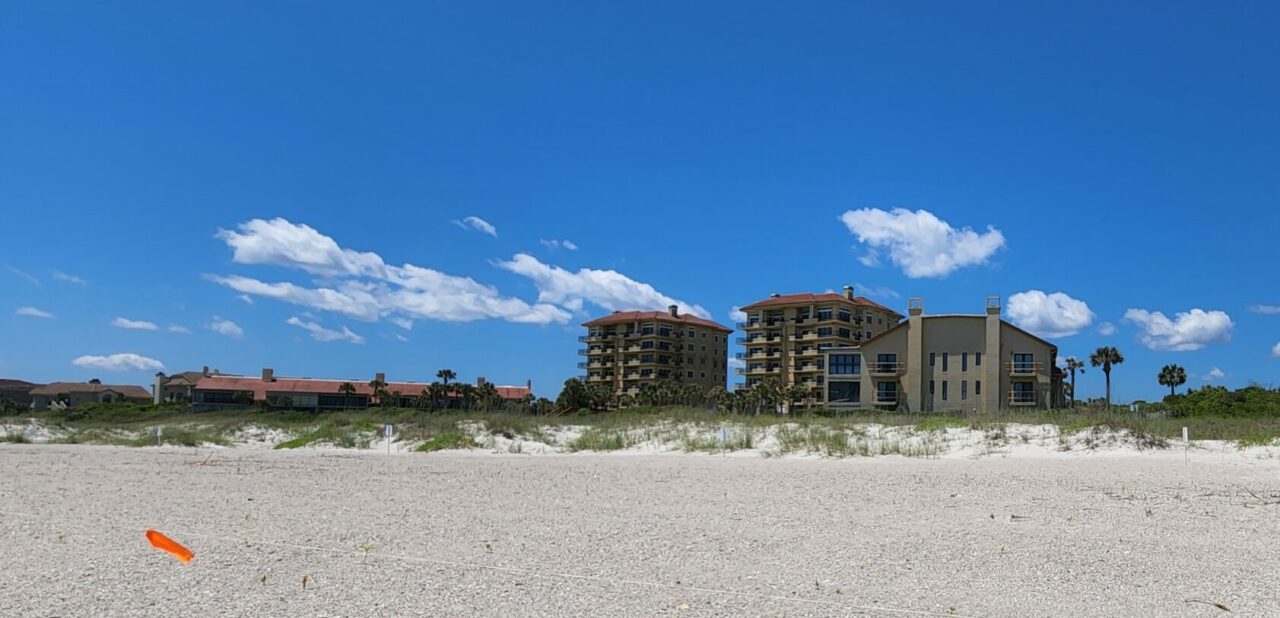
A proposed settlement between Riverstone Properties and Nassau County would allow previously banned tower heights for the south end of Amelia Island. In return, the county would receive a beach access point, albeit one that doesn’t open up any new beach to the public, and is a few hundred yards away in either direction from another beach access to the north and Amelia Island State Park to the south.
“The County agrees that the maximum building height for multiple-family dwellings and other permitted structures on the Property is eighty-five (85) feet,” according to the settlement agreement. “Height shall be measured from the approved finished grade.
“The County agrees that this right shall continue in perpetuity, regardless of any future changes in ownership of the Property, any future amendment of the Land Development Code, or any future amendment of the Comprehensive Plan.”
Riverstone owns around 50 acres of land on the east side of the First Coast Highway in the unincorporated part of the island. It sued under the Bert Harris Act.
“Because Riverstone is located in the RG-2 zoning district and because ninety (90) percent of Riverstone’s Property falls within 1,000 feet of the (Coastal Construction Control Line), the maximum permitted height for the majority of Riverstone’s Property under the proposed Ordinance was 35 feet,” according to Riverstone’s complaint.
“As a result, the proposed Ordinance severely limited the number of oceanfront residential units that Riverstone would be able to develop on the Property.”
The ordinance referenced in the complaint drops the RG-2 permitted height in the unincorporated part of the island to 45 feet, and lower to 35 feet for land within 1,000 feet of the Coastal Construction Control Line. As the ordinance mainly affects Riverstone’s property, its lawyers argue Commissioners specifically targeted the company.
Amelia Island residents’ groups took to social media, with one person calling it a win/win. But the administrator of the Conserve Amelia Now! group said it was a raw deal for everyone but the developers.
“How does a 200-foot track of land (accompanied by an $11 million dollar tax break!) benefit local members of our community?” Perry Rae wrote in an email to County Commissioners and posted to Facebook.
“This park would sit almost 20 miles from the Wildlight development (a drive of over 30 minutes), obviously farther for residents of Callahan and Hillard. More likely is that this park would appeal mostly to Jacksonville residents, who pay no taxes to the upkeep of our community and won’t have to deal the obstructed views on a daily basis.”
Amelia Island is Old Florida, she said, not Miami, and residents worked specifically to create that atmosphere.
The matter is expected to come up at the next two County Commission meetings, scheduled for May 18 and 23. Residents spoke against allowing the towers at a late April meeting as well.
Amelia Island resident Jack Roberts said at that meeting the Commission did nothing wrong in its height ordinance, and argued against the company’s claim that the land lost value.
“In fact, we think they can make even more money if they’ll shift their focus to single-family residential, high-end homes,” he said.




2 comments
John Clark
May 12, 2022 at 5:33 pm
Don’t you think a short explanation of “The Bert Harris Act” might have been in order? Thanks
It's Complicated
May 13, 2022 at 11:29 am
Bert Harris Private Property Act
https://www.legalteamusa.net/what-is-the-bert-harris-private-property-protection-act/
“Florida is one of the only states in the U.S. that has a statute that gives a cause of action to a property owner when the state or local government takes an action that reduces the value of a property. This occurs by interfering with an existing use or a vested right without that government action rising to the level of a taking. The statute that creates this cause of action is known as the Bert Harris Private Property Act (chapter 70 of the Florida Statutes).”
“Under Florida law, a taking only occurs when there is a physical invasion of the land or the government causes a loss of all economically viable use. The reduction in the property value must come from an inordinate burden placed on an existing use or vested right of the property that causes the property owner to be unable to obtain the reasonable investment-backed expectations for the existing use or vested right.”
Comments are closed.